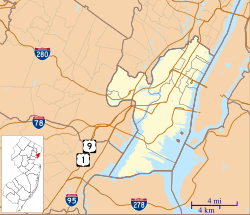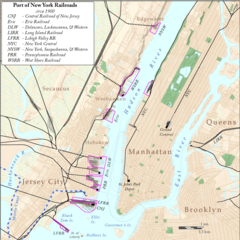Communipaw Terminal
|
Central Railroad of New Jersey Terminal
|
||||||||||||||||||||||||||
|---|---|---|---|---|---|---|---|---|---|---|---|---|---|---|---|---|---|---|---|---|---|---|---|---|---|---|
| Former Reading Railroad station | ||||||||||||||||||||||||||

CNJ Terminal at Liberty State Park showing ferry slips serving boats to Statue of Liberty National Monument, Ellis Island and Liberty Island (2013)
|
||||||||||||||||||||||||||
| Location |
Liberty State Park Jersey City, New Jersey |
|||||||||||||||||||||||||
| Construction | ||||||||||||||||||||||||||
| Disabled access | No | |||||||||||||||||||||||||
| Electrified | No | |||||||||||||||||||||||||
| Services | ||||||||||||||||||||||||||
No services
|
||||||||||||||||||||||||||
|
Central Railroad of New Jersey Terminal
|
||||||||||||||||||||||||||
| Location |
Liberty State Park Jersey City, New Jersey |
|||||||||||||||||||||||||
| Coordinates | 40°42′26″N 74°2′7″W / 40.70722°N 74.03528°WCoordinates: 40°42′26″N 74°2′7″W / 40.70722°N 74.03528°W | |||||||||||||||||||||||||
| Area | 63 acres (25 ha) | |||||||||||||||||||||||||
| Built | 1889 | |||||||||||||||||||||||||
| Architect | William H. Peddle, Peabody & Stearns | |||||||||||||||||||||||||
| Architectural style | Richardsonian Romanesque | |||||||||||||||||||||||||
| NRHP Reference # | ||||||||||||||||||||||||||
| NJRHP # | 1513 | |||||||||||||||||||||||||
| Significant dates | ||||||||||||||||||||||||||
| Added to NRHP | September 12, 1975 | |||||||||||||||||||||||||
| Designated NJRHP | August 27, 1975 | |||||||||||||||||||||||||
| Location | ||||||||||||||||||||||||||
|
Location on a map showing the railroads in the New York City area ca 1900
|
||||||||||||||||||||||||||
The Central Railroad of New Jersey Terminal, also known as Communipaw Terminal and Jersey City Terminal, was the Central Railroad of New Jersey's waterfront passenger terminal in Jersey City, New Jersey. It was also serviced by the Reading Railroad, Baltimore and Ohio Railroad, and Lehigh Valley Railroad during various periods in its 78 years of operation. The current terminal building was constructed in 1889 but was abandoned in 1967. The headhouse was later renovated. It was later added to the New Jersey Register of Historic Places and incorporated into Liberty State Park. The terminal was one of five passenger railroad terminals that lined the Hudson Waterfront during the 19th and 20th centuries, the others being Weehawken, Hoboken, Pavonia and Exchange Place.
The terminal was built in 1889, replacing an earlier one that had been in use since 1864. It operated until April 30, 1967. The station has been listed on the New Jersey Register of Historic Places and National Register of Historic Places since September 12, 1975. Additionally it is a .
The terminal is part of Liberty State Park, and along with nearby Ellis Island and Statue of Liberty recalls the era of massive immigration through the Port of New York and New Jersey. It is estimated that around 10.5 million entered the country through the station. The area has long been known as Communipaw, which in the Algonquian language Lenape means big landing place at the side of a river . The first stop west of the station was indeed called Communipaw, and was not far from the village that had been established there in 1634 as part of the New Netherland settlement of Pavonia. The land on which the extensive yards were built was reclaimed, or filled. The terminal itself is next to the Morris Canal Big Basin, which to some degree was made obsolete by the railroads which replaced it. The long cobbled road which ends at the terminal (once called Johnston Avenue for a president of CNJ) is Audrey Zapp Drive, for the environmentalist active in the creation of the park.
...
Wikipedia




